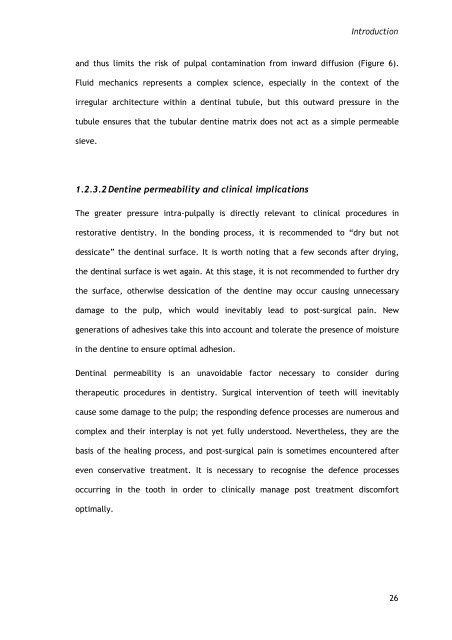Molecular characterisation of odontoblast during primary, secondary ...
Molecular characterisation of odontoblast during primary, secondary ...
Molecular characterisation of odontoblast during primary, secondary ...
You also want an ePaper? Increase the reach of your titles
YUMPU automatically turns print PDFs into web optimized ePapers that Google loves.
Introduction<br />
and thus limits the risk <strong>of</strong> pulpal contamination from inward diffusion (Figure 6).<br />
Fluid mechanics represents a complex science, especially in the context <strong>of</strong> the<br />
irregular architecture within a dentinal tubule, but this outward pressure in the<br />
tubule ensures that the tubular dentine matrix does not act as a simple permeable<br />
sieve.<br />
1.2.3.2 Dentine permeability and clinical implications<br />
The greater pressure intra-pulpally is directly relevant to clinical procedures in<br />
restorative dentistry. In the bonding process, it is recommended to “dry but not<br />
dessicate” the dentinal surface. It is worth noting that a few seconds after drying,<br />
the dentinal surface is wet again. At this stage, it is not recommended to further dry<br />
the surface, otherwise dessication <strong>of</strong> the dentine may occur causing unnecessary<br />
damage to the pulp, which would inevitably lead to post-surgical pain. New<br />
generations <strong>of</strong> adhesives take this into account and tolerate the presence <strong>of</strong> moisture<br />
in the dentine to ensure optimal adhesion.<br />
Dentinal permeability is an unavoidable factor necessary to consider <strong>during</strong><br />
therapeutic procedures in dentistry. Surgical intervention <strong>of</strong> teeth will inevitably<br />
cause some damage to the pulp; the responding defence processes are numerous and<br />
complex and their interplay is not yet fully understood. Nevertheless, they are the<br />
basis <strong>of</strong> the healing process, and post-surgical pain is sometimes encountered after<br />
even conservative treatment. It is necessary to recognise the defence processes<br />
occurring in the tooth in order to clinically manage post treatment discomfort<br />
optimally.<br />
26
















